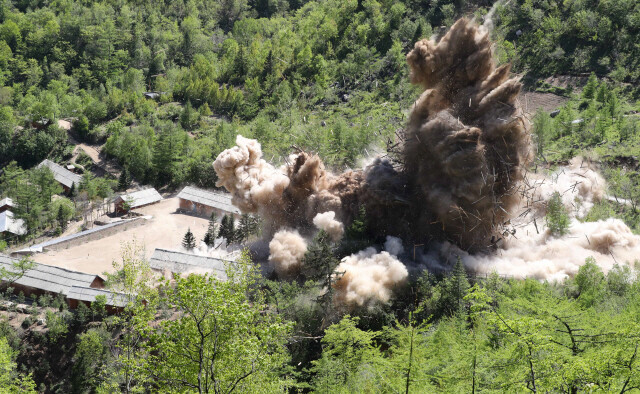hankyoreh
Links to other country sites 다른 나라 사이트 링크
Defectors from N. Korean nuke test site region show no significant radiation exposure

The South Korean Ministry of Unification revealed on Thursday that there was “no significant level of radioactive contamination” among 80 defectors who had resided in eight cities and counties surrounding North Korea’s nuclear test site.
A test was carried out to determine the radiation exposure and radioactive contamination levels of those who hailed from areas including Kilju County in North Hamgyong Province, home of the Punggye test site.
This confirms that there have been no cases of radiation exposure or radioactive contamination from any nuclear tests carried out by the North.
The ministry, along with the Korea Hana Foundation, which aids North Korean defectors, released a report on the results of a radiation exposure and radioactive contamination level test on North Korean defectors conducted by the Korea Institute of Radiological and Medical Sciences National Radiation Emergency Medical Center.
The test subjects were 80 North Korean defectors who had resided in six counties — Kilju, Hwadae, Myonggan, Myongchon, Orang, and Paekam — and two cities (Kimchaek and Tanchon), near the nuclear test site since North Korea conducted its first nuclear test on Oct. 9, 2006.
After conducting radioactive contamination tests and radiation exposure tests (biological dosimetry) on the 80 North Koreans, KIRMAS revealed that “none of the test subjects showed meaningful results.”
While some examinees demonstrated figures higher than the minimum detection threshold in their radiation exposure tests, such numbers were attributed to “variables that occurred after their defection or by exposure to medical radiation,” which are “unlikely to be related with the levels of radiation exposure before their defections.”
An official from KIRAMS explained, “The results of the chromosome aberration analysis showed figures that could have been produced by medical radiation exposure, so we cannot conclude that the chromosome aberrations happened due to exposures from nuclear tests.”
Public controversy over whether North Koreans with a history of living in areas near the country’s nuclear test site have been exposed to radiation has been ongoing since November 2016, when the South and North Development Institute, an organization concerned with North Korea issues and defectors, published the results of five North Korean defector’s radiation exposure tests.
Such controversy has spread to the National Assembly and the Ministry of Unification has previously conducted two closed-door radiation exposure tests of defectors in 2017 and 2018.
By Lee Je-hun, senior staff writer
Please direct questions or comments to [english@hani.co.kr]

Editorial・opinion
![[Column] Season 2 of special prosecutor probe may be coming to Korea soon [Column] Season 2 of special prosecutor probe may be coming to Korea soon](https://flexible.img.hani.co.kr/flexible/normal/500/300/imgdb/original/2024/0426/3317141030699447.jpg) [Column] Season 2 of special prosecutor probe may be coming to Korea soon
[Column] Season 2 of special prosecutor probe may be coming to Korea soon![[Column] Park Geun-hye déjà vu in Yoon Suk-yeol [Column] Park Geun-hye déjà vu in Yoon Suk-yeol](https://flexible.img.hani.co.kr/flexible/normal/500/300/imgdb/original/2024/0424/651713945113788.jpg) [Column] Park Geun-hye déjà vu in Yoon Suk-yeol
[Column] Park Geun-hye déjà vu in Yoon Suk-yeol- [Editorial] New weight of N. Korea’s nuclear threats makes dialogue all the more urgent
- [Guest essay] The real reason Korea’s new right wants to dub Rhee a founding father
- [Column] ‘Choson’: Is it time we start referring to N. Korea in its own terms?
- [Editorial] Japan’s rewriting of history with Korea has gone too far
- [Column] The president’s questionable capacity for dialogue
- [Column] Are chaebol firms just pizza pies for families to divvy up as they please?
- [Column] Has Korea, too, crossed the Rubicon on China?
- [Correspondent’s column] In Japan’s alliance with US, echoes of its past alliances with UK
Most viewed articles
- 1Is Japan about to snatch control of Line messenger from Korea’s Naver?
- 2‘We must say no’: Seoul defense chief on Korean, USFK involvement in hypothetical Taiwan crisis
- 3S. Korea “monitoring developments” after report of secret Chinese police station in Seoul
- 4The dream K-drama boyfriend stealing hearts and screens in Japan
- 5Division commander ordered troops to enter raging flood waters before Marine died, survivor says
- 6[Editorial] New weight of N. Korea’s nuclear threats makes dialogue all the more urgent
- 7No good, very bad game for Korea puts it out of Olympics for first time since 1988
- 8[Column] ‘Choson’: Is it time we start referring to N. Korea in its own terms?
- 9‘Weddingflation’ breaks the bank for Korean couples-to-be
- 10[Column] Season 2 of special prosecutor probe may be coming to Korea soon